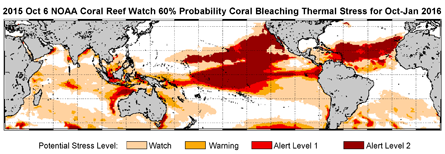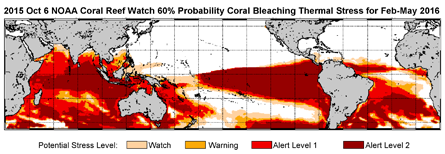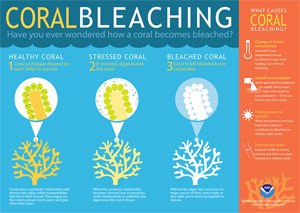- STAR Home
- > News &
Events
- > 9 October 2015 - NOAA's Coral Reef Watch and Partners Announce 3rd Global Bleaching Event
NOAA's Coral Reef Watch and Partners Announce 3rd Global Bleaching Event
9 October 2015 -
As record ocean temperatures cause widespread coral bleaching across
Hawaii, NOAA scientists confirm similar warm ocean waters are
now causing bleaching across much of the northern Caribbean and may
expand, prompting the declaration of the third global coral bleaching
event on record. "The coral bleaching and disease, brought on by climate
change and coupled with events like the current El Niño, are the largest
and most pervasive threats to coral reefs around the world," said Mark
Eakin, NOAA's Coral Reef Watch
coordinator. "As a result, we are losing huge areas of coral across
the U.S., as well as internationally. What really has us concerned
is this event has been going on for more than a year and our long-range
model projections indicate the bleaching is likely to last well into
2016, when it may be even worse."
This announcement stems from the latest NOAA Coral Reef Watch satellite
coral bleaching monitoring products, and was confirmed through reports
from partner organizations with divers working on affected reefs,
especially the XL Catlin Seaview Survey and ReefCheck. NOAA Coral Reef
Watch's bleaching outlook, which forecasts the potential for coral
bleaching worldwide several months in the future, predicted this global
event in July 2015.
Coral Reef Watch - Bleaching Projections

NOAA Coral Reef Watch - 6 Oct 2015
- 60% Probability Coral Bleaching Thermal Stress for Oct-Jan 2016
(click to enlarge)

NOAA Coral Reef Watch - 6 Oct 2015
- 60% Probability Coral Bleaching Thermal Stress for Feb-May 2016
(click to enlarge)
Satellite data from NOAA's Coral Reef Watch program provides
current reef environmental conditions to quickly identify areas at risk for
coral
bleaching, while its climate model-based outlooks provide managers with
information on potential bleaching months in advance.
The outlooks
were developed jointly by NOAA's Satellite and Information
Service and the National Centers for
Environmental Prediction through funding from the Coral Reef Conservation Program and
the Climate Program Office.
What is coral bleaching?
 Warmer water temperatures
can result in coral bleaching. When water
is too warm, corals will expel the algae (zooxanthellae) living in their
tissues causing the coral to turn completely white. This is called coral
bleaching. When a coral bleaches, it is not dead. Corals can survive a
bleaching event, but they are under more stress and are subject to
mortality. Warmer water temperatures
can result in coral bleaching. When water
is too warm, corals will expel the algae (zooxanthellae) living in their
tissues causing the coral to turn completely white. This is called coral
bleaching. When a coral bleaches, it is not dead. Corals can survive a
bleaching event, but they are under more stress and are subject to
mortality.
Why are coral reefs important?
Coral reefs comprise less than 1/10th of 1 percent of the ocean's total area.
But they're vitally important both to ecosystems and to people who
depend on them.
- One in every four species of fish live on a coral reef;
- There are over a million species that live on coral reefs;
- Coral reefs provide food and livelihood to 500 million people worldwide;
Thanks to Mark Eakin, Coral Reef Watch, the Washington Post,
Keeley Belva at NOAA Public Affairs, National Ocean Service, and
XL Caitlin Seaview Survey for contributions to this story.
|



